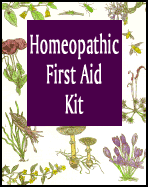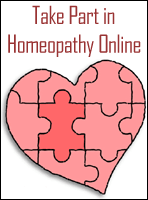|
Introduction
A study of any field of alternative medicine such as homeopathy is likely to take the student into a whole host of derivative concepts ranging from ancient religious rituals to quantum physics. Almost any book on the subject is going to contain a full range of holistic jargon that has no agreed upon meaning by people in the field. "We are fields of energy with a reality separate from the mind" we might be told.
There is nothing wrong here in the sense that any assertion can be proved or disproved. The problem is that people are answering a question that we don't know about yet. Does the answer tell us why we get sick and what the process will be to get better? Are we accepting the process on faith as a substitute for what we might discover is a principle that can be used to improve our current health practice?
The establishment doctors have stayed away from developing the same sort of holistic principles and rely on chemical effects and lab tests resulting in more detailed information. They look on the alternative field with cynicism and containing a lack of ability to provide the bridge that would they would like to arrive at so that the laws of healing would derive benefit to the unquestionably disordered bodies they see but have no hope of helping.
The current popularity of mind-body study has not brought a solid bond between the need of logical inquiry and the desire to understand the murky connection between the curative powers of the mind and the illness. Instead it has opened the door to the dialog of internal mythologies which ends in belief or disbelief by a matter of faith.
On this web site, there will be no mention of metaphysical concepts unless they are labeled as such and the known facts surrounding the important principles are revealed.
Principles of homeopathy
Totality of the symptoms
It is in the collection of all of the symptoms of the patient that the disease will be finally known. Hahnemann specifically noted that the most unusual symptoms were the ones that held the most promise for identifying the specific disease picture since many disease pictures look alike. The totality of the symptoms gathered from the physical, the emotional and the mental planes are what will guide the homeopath to the correct diagnosis.
Once the symptom picture has been taken and the totality of the symptoms are known, it is then that the remedy that best matches the disease picture, the simillimum, is sought after. By best matching the symptoms that are caused in healthy people by a substance with the picture of the patient’s symptoms, it will be found that that substance has the best chance of producing a curative response in the patient This is called the Law of Similars.
Minimum dose
The reduction of the chemical quantity of the curative substance should be carried out until the least amount produces a curative response. That limits the side effects of the chemical nature of the substance and increases the gentle action of the remedy. The substance is diluted and shaken repeatedly until the desired potency is achieved.
Single remedy
Although there are three laws of homeopathy, this is more of a tenet of scientific integrity which then allows you to say classical homeopathy. By choosing to give only one remedy at a time, it is sure that you know what results it will have. By combining several therapies or remedies at one time, not only are you not sure which one of the substances is causing a cure, but you are unable to determine if there is a drug interaction which helps cure or even worse, an effect as a result of the two working against the patient.
The process
| Remedy picture |
Symptom picture |
We identify a medicinal substance. |
Patient identifies illness. |
A proving is made. |
The case is taken. |
The symptoms are recorded and indexed. |
The symptoms are recorded and detailed. |
A summary of the remedy is made. |
A summary of the patient is made. |
The best match is made. |
Principles of medicine
The purpose of medicine
Healing the sick
Most medical practices today are concerned with taking care of fires. It's a popular business management style as well since usually until someone messes something up, no one notices.
When you think your body messes up, it becomes a center of attention for you and the health practitioners. And after you are healed through a cure, your physicians move on to others trying to put out their fires until you return to that state of imbalance of disease.
Diets are usually concerned with not maintaining a weight but removing it so most diets should be considered a curative diet. There are many strange combinations that work for getting body weight down but if a person remains on that diet, they will fall ill due to malnutrition or find themselves bingeing to fulfill their desires so long repressed.
The healing process should be short and the health process a long one. Homeopathy is concerned with both, but most study goes into helping the body to recover through the use of remedies. If you are serious about caring for people’s health then it is just as important to know the balancing side of health care.
Improving and maintaining health
It is never too early (or too late) to think about how to improve your health. But looking at how to cure disease is only one part of a healthy lifestyle. It is also important to maintain health through several different methods that are readily available to us. Hahnemann was a pioneer in demanding a health-conscious lifestyle from the people he was around.
An increasing trend that has surfaced in health care management organizations is the belief that we have diseases that can be categorized and related to any ultimate cause of death. Most of us can live out our lives without chronic disease or disability and succumb only to old age when the time is finally up. The goal of a healthy life is as Dr. Ernst Wynder, president of the American Health Foundation put it, to “die young as late in life as possible.”
90 percent of your health is determined by factors beyond medicine’s control: your genetic background, the healthfulness of your environment, and most important, how you live – what and how much you eat, your drinking and smoking habits, how much your exercise, and how you relax.
As homeopaths, we may hold the key to many paths away from disease but in promoting good health through lifestyle choices we can keep people from getting on the path to disease in the first place. Our genes predispose us to certain types of disease but unless we encourage them to do their dirty work, they will never express their dissatisfaction with our choices.
You’ve heard that our life expectancy has increased over the time when homeopathy was introduced and many principles were adopted by conventional medicine. That’s true but it’s been due to fewer deaths in infancy, in childhood, and after childbirth – the result of improved sanitation, immunizations, and antibiotics. Among middle-aged Americans, however, men live only four years longer, and women only seven years longer that did their counterparts at the turn of the century. It is more of our responsibility to improve and keep our health that it is of the physician’s. Remind yourself often that a pill will never be the solution to any ailment that you may have.
The recommendations that make up for a healthy life are based around a few principles:
- Avoid hazardous behaviors such as cigarettes, excess alcohol and calories, mind-altering drugs, unsafe driving and recreational practices, misuse of dangerous tools.
- Pursue health-enhancing activities, such as regular exercise, a proper diet, and protective health measures such as routine check-ups.
- Get proper diagnosis and treatment. Know the limits of what you can do and don’t hope for any more when your or another person’s health is at risk.
A personal health inventory is a way to check your health so that you know of the hazards you or the people you work with are exposed to. This determines your health age. It should be no greater than your chronological age, and the lower it is than your chronological age, the better.
Process of medicine
What is the process that the physician uses to provide consistent care to their patients? How can the method be repeated and taught to other students of medical care? What is the best way to use each of the steps of that process? When you look at the parts of the procedure, you will find variation in the disciplines but an overall agreement on how to approach the subject.
Diagnosis
A physician may be hastily called to the home of an elderly person with few but violent symptoms. Almost immediately, the family is concerned for a prognosis where correctness is a matter of great importance. The medical professional uses their knowledge of pathology for the conclusion of the case in regards to the nature, cause and probably termination of the disease. It is a question of identification and not cure at this point.
One possible result of a thorough diagnosis is that the patient needs mechanical or hygienic attention. Another would be that the patient needs therapeutic attention. It would be the knowledge of pathology that would allow the physician to make the decision of a physical cause that should be removed surgically or in the environment or that the patient is in need of other treatment.
It is most important that the vision of what is in disorder is made clear by the knowledge of what is the normal functioning of the human body. For that reason, it would be wise to undertake the study of first aid, anatomy, pathology, and physiology on your own, through extension courses or what ever method suits your study habits.
Therapeutics and hygiene
In working with physiology, we are concerned with the general stimuli and general susceptibilities of the human organism. To formulate the relationships of special stimuli and susceptibilities it is necessary to do many trials and errors, recording and verifying all of the actions and reactions. By deduction, then, are the empirical laws formed that become the laws of therapeutics.
After applying the special stimuli to the diseased organism, then comes the restoration and maintenance of a proper equilibrium of the general stimuli which is the science of hygiene.
In homeopathy, the science of therapeutics tends to lean towards the non-chronic ailments and thus towards a more conventional approach to the use of the remedies as drugs. |


